How to Create a Comprehensive “How-to- Guide”?
The onlookers who are always on a journey to learn something new and explore the possibilities in life know the importance of “How to Guides”.
Ever since people started finding information on the internet like “How to fix your laptop” or “How to make a canva poster”, “How to start your own blog” etc, the relevance of “How to Guides” has increased.
Well if you have a skill and you want audiences to read it, you must know how to make guide book.
Read further.
What is a How-to Guide?
A how-to guide is instructional content that gives detailed, step-by-step directions on how to do a specific task or reach a particular goal. Its purpose is to help people learn or become skilled at something, finish a project, or resolve a problem.
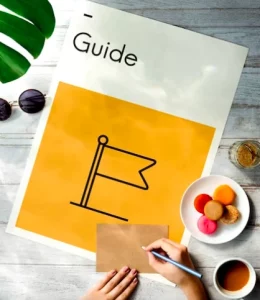
How-to guides are made to take complicated procedures and make them more accessible for a larger group of people to understand. They usually have a well-structured layout that breaks down the task into smaller, doable steps. These steps are often explained with the help of visuals, illustrations, diagrams, or examples to improve comprehension and make learning easier.
- A how-to guide gives people the know-how and abilities to achieve a particular objective.
- These guides can encompass various subjects like cooking, DIY projects, technology, crafts, gardening, fitness, and more.
- By following the directions provided in a how-to guide, individuals can acquire practical skills, boost their confidence, and effectively tackle tasks that might have seemed complex or unfamiliar.
Guide to guides are commonly found in various formats, including books, manuals, websites, blogs, videos, and online tutorials. They are widely utilised as educational resources, reference materials, and self-help tools.
With the availability of such guides, individuals can acquire new skills, tackle challenges independently, and explore their interests with greater ease.
Also Read: How to write a case study that drive sales?
How to make a guidebook?
To craft a how-to guide, there are several essential steps to guarantee it is clear, well-organized, and useful.
Here’s a basic breakdown of the procedure
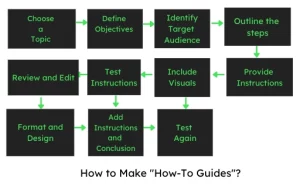
Choose a Topic:
Select a specific topic or task that you want to create a guide for. It should be something you have expertise in or have thoroughly researched.
Define the Objective:
Clearly state the objective or goal of your guide. What do you want the readers to accomplish by following your instructions?
Identify the Target Audience:
Determine who your intended audience is. Consider their level of expertise, prior knowledge, and any specific requirements they may have. This will help you tailor your guide to their needs.
Outline the Steps:
Break down the task or process into smaller, sequential steps. Start with an overview and then delve into the details. Make sure each step is clear, concise, and easy to follow.
Provide Clear Instructions:
Write clear and precise instructions for each step. Use simple language, avoid jargon, and provide examples or illustrations where necessary to enhance understanding.
Include Visuals:
Visual aids such as images, diagrams, or videos can significantly enhance the clarity of your guide. Use visuals to supplement your instructions and demonstrate key points.
Test the Instructions:
Put yourself in the reader’s shoes and test the instructions yourself. Ensure that each step can be quickly followed and that the desired outcome is achievable.
Review and Edit:
Review your guide for errors, inconsistencies, or unclear instructions. Edit the content to improve readability and ensure a logical flow of information.
Format and Design:
Choose a suitable format for your guide, whether a document, web page, or video script. Use headings, subheadings, bullet points, and formatting techniques to improve readability.
Add Introduction and Conclusion:
Include an introduction that explains the guide’s purpose and provides an overview of what the readers can expect. End with a conclusion that summarises the key points and reinforces the accomplishment of the objective.
Test Again:
Have someone who represents your target audience test your guide. Gather feedback and make any necessary revisions to improve clarity and usability.
Publish and Distribute:
Choose a platform to publish your guide, such as a website, blog, or video hosting platform. Make it easily accessible to your intended audience.
Effective tips for “How-to Guides”
These are some effective tips for how-to guides:
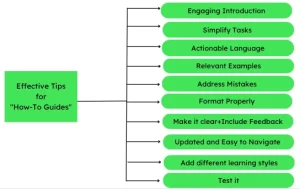
Begin with an Engaging Introduction:
Start your guide with a compelling introduction that grabs the reader’s attention. Clearly state the problem or need that your guide addresses and explain why it’s essential to solve it.
Break Down Complex Tasks:
If the task or process you’re explaining is complex, break it down into smaller, manageable steps. This helps readers follow along easily and prevents them from feeling overwhelmed.
Use Actionable Language:
Write your instructions in a clear and actionable manner. Use active verbs and direct language to convey what readers need to do. For example, instead of saying, “The user should click on the button,” say, “Click the button.”
Include Relevant Examples:
Include examples or case studies to illustrate your instructions. Real-life scenarios or practical examples can help readers understand how to apply the instructions in different situations.
Address Common Mistakes:
Anticipate common mistakes or pitfalls that readers might encounter and provide guidance on avoiding or overcoming them. This helps readers navigate potential challenges and increases their chances of success.
Use Formatting and Visual Cues:
Use formatting techniques like bolding, bullet points, or numbering to highlight important information or steps. This makes the content more scannable and easier to follow. Consider using different colours, icons, or callout boxes to highlight key points.
Provide Supplementary Resources:
If applicable, include additional resources such as reference materials, templates, or links to external websites. This allows readers to explore further and deepen their understanding of the topic.
Test for Clarity and Usability:
Have someone unfamiliar with the topic or process test your guide. Observe their experience and ask for feedback on any areas that might be unclear or confusing. Use this feedback to improve the clarity and usability of your guide.
Seek User Feedback:
Encourage users following your guide to provide feedback or ask questions. This helps you understand their needs better and refine your instructions based on their real-world experiences.
Keep It Updated:
Regularly review and update your how-to guide to ensure its accuracy and relevance. As technologies, tools, or best practices evolve, make the necessary revisions to keep your guide up to date.
If your guide is in digital format, ensure it has clear headings, subheadings, and a table of contents for easy navigation. This allows readers to quickly find the information they need.
Consider Different Learning Styles:
People have different learning styles, so incorporate various instructional methods. This may include written instructions, visuals, diagrams, videos, or interactive elements to cater to different preferences and enhance comprehension.
“How-to Guide” Examples
One of the prime illustrations of a brand acclaimed for its thorough and easy-to-follow how-to guides is “iFixit.” iFixit is a company that offers repair instructions and materials for everyday electronic devices and gadgets. They are renowned for their meticulous, step-by-step directions and excellent visuals, which simplify the process of fixing devices for individuals.
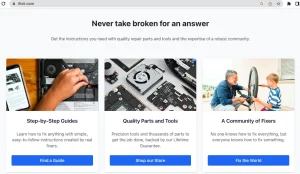
iFixit’s how-to guides encompass a broad spectrum of electronic gadgets, including smartphones, laptops, gaming consoles, and other popular devices. These guides typically contain step-by-step disassembly instructions, troubleshooting advice, and necessary tools and replacement parts recommendations.
What makes iFixit unique is its dedication to empowering users and advocating for the right to repair. They offer valuable resources to people who wish to prolong the life of their devices or undertake repairs independently.
iFixit’s how-to guides are accessible on their website, which hosts an extensive collection of repair guides, teardowns, and community-driven discussions. They have gained a strong reputation for their comprehensive, dependable, and user-friendly guides, setting a notable example for how-to guides.
Another example of guide to guides is that of Adobe.
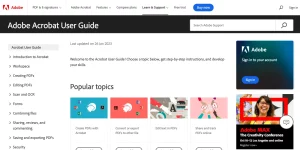
Adobe is a renowned software company that provides various creative tools and solutions.
- They offer detailed how-to guides and tutorials to help users learn and master their software products effectively.
- Adobe’s how-to guides cover various creative disciplines, such as graphic design, video editing, photography, and web development.
- They provide step-by-step instructions, tips, and techniques to help users leverage the full potential of Adobe software.
What sets Adobe apart is its dedication to education and user support. They understand that their software can be complex, so they strive to make learning accessible and enjoyable. Adobe empowers users to enhance their creative skills and achieve professional results through their how-to guides.
Adobe’s how-to guides are available on its official website, which features an extensive library of tutorials, articles, and resources. Users can access these guides to learn new techniques, troubleshoot issues, and discover creative possibilities within Adobe software.
Adobe’s commitment to providing informative and user-friendly how-to guides makes them a notable example of a brand prioritising education and customer support in creative software.
Conclusion
A well-crafted how-to guide is invaluable for effectively communicating complex processes or tasks. Breaking down the information into clear, concise steps and utilising visuals empowers readers to learn new skills and achieve desired outcomes.
At Noboru World, we understand the importance of designing and communicating messages effectively. If you need assistance creating compelling how-to guides or any other communication needs, please contact us at hello[at]noboruworld.com. Let us help you simplify the complex and guide your audience towards success.
FAQ
What is a how-to guide?
A how-to guide is an instructional resource that provides step-by-step instructions on performing a specific task or achieving a particular goal. It simplifies complex processes and helps individuals learn new skills or solve problems.
Why are how-to guides important?
A how-to guide is an instructional tool that offers a series of clear, step-by-step directions for accomplishing a specific task or attaining a particular objective. These guides simplify complicated processes and assist individuals in acquiring new skills or resolving issues.
Where can I find how-to guides?
How-to guides come in diverse forms, such as books, manuals, websites, blogs, videos, and online tutorials. They exist both in physical and digital versions, covering a wide array of subjects and interests.
How do I create a practical how-to guide?
To create an effective how-to guide, start by defining the objective, understanding your audience, breaking down the task into clear steps, providing concise instructions, using visuals, and anticipating potential issues. Testing, editing, and incorporating feedback are crucial for clarity and effectiveness.
Can anyone create a how-to guide?
Anyone with knowledge or expertise in a particular area can create a how-to guide. It requires a clear understanding of the topic, the ability to communicate instructions effectively, and a willingness to help others learn or accomplish tasks.
Are there any specific guidelines for creating a how-to guide?
While there are no strict rules, there are general guidelines. These include defining the objective, using clear language, providing visuals, organising the content logically, addressing potential challenges, and keeping the guide concise and easy to follow.



